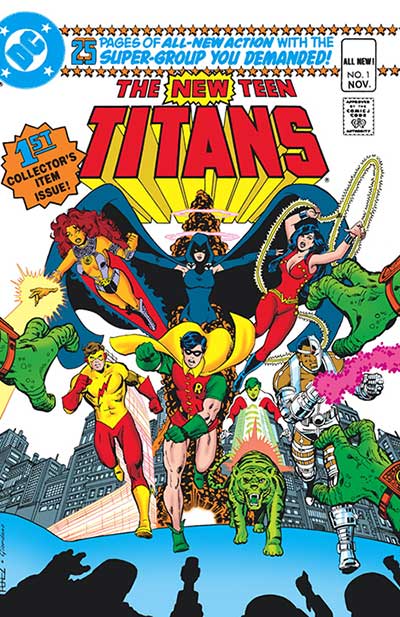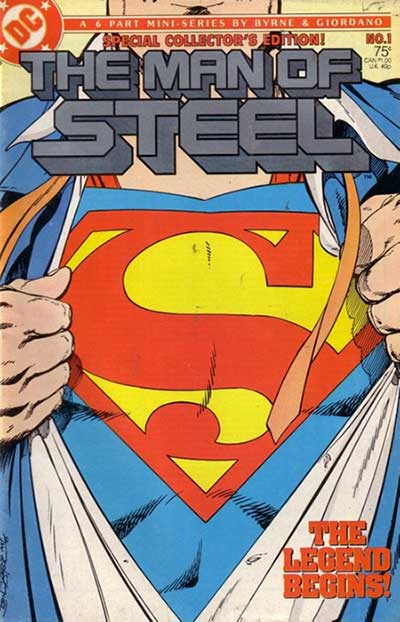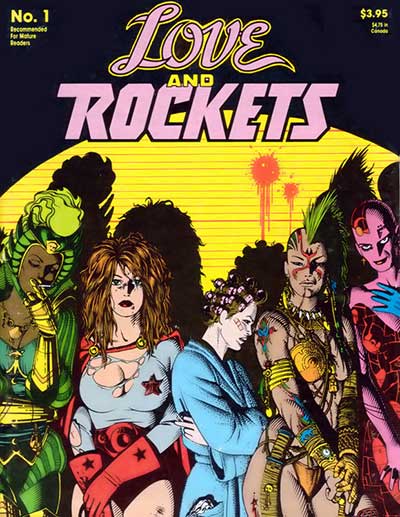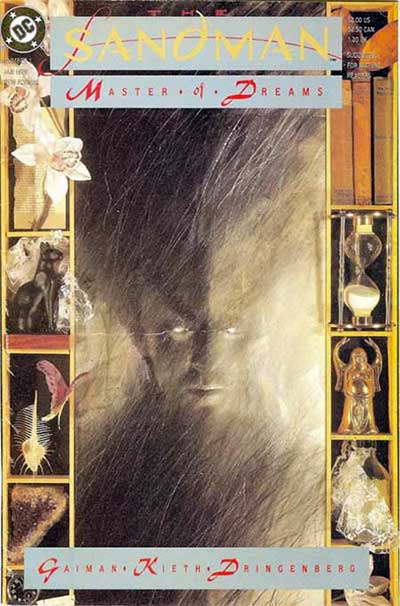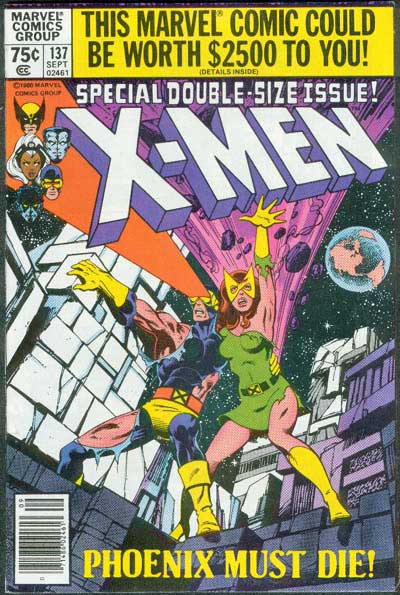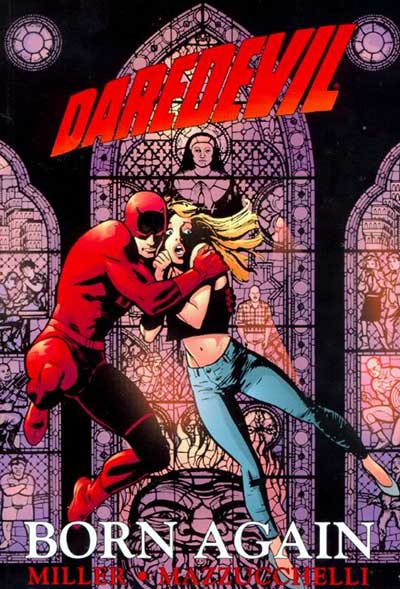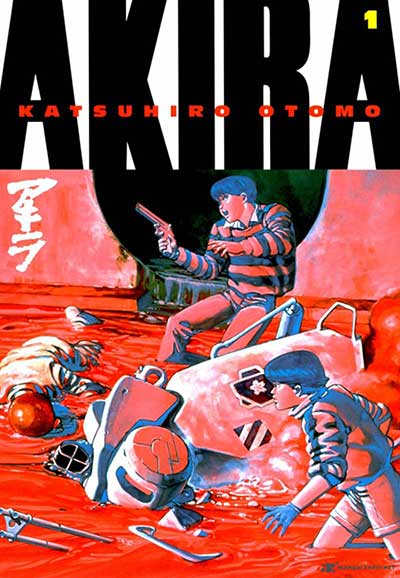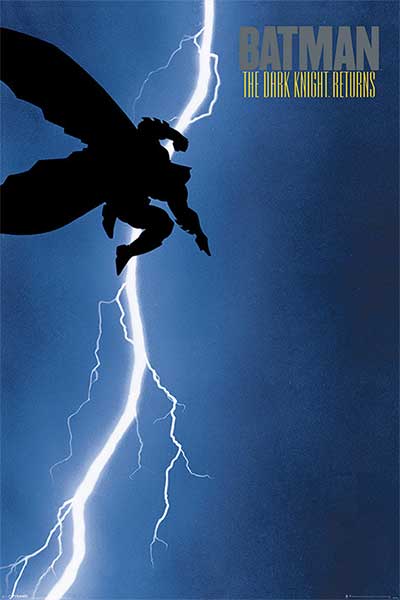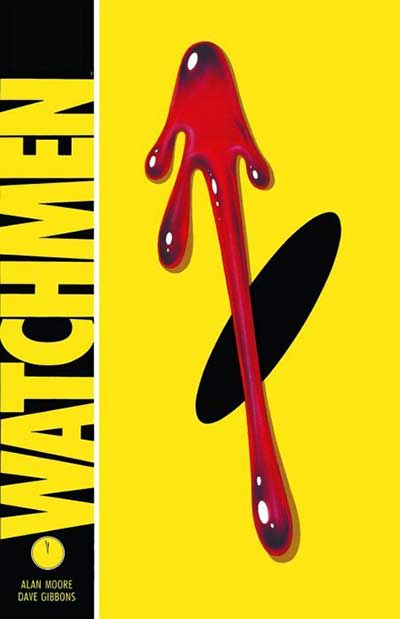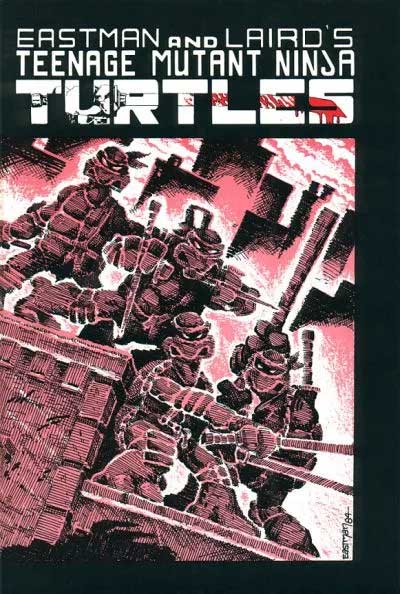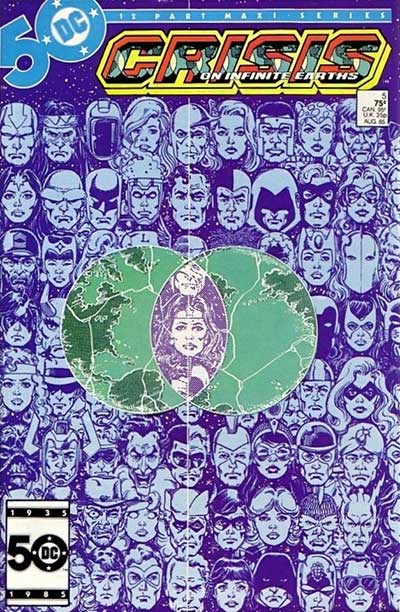Comics /
Spotlight
Top Ten Comics of the 1980s
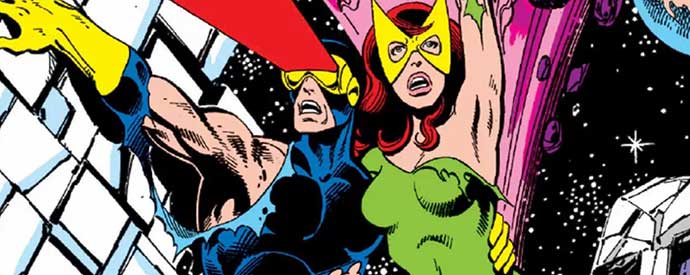
By Hervé St-Louis
March 31, 2021 - 00:36
Comic book readers of the Bronze age were in for many changes in the North American comic book industry. Changes that happened that decade included the shift from newsstand comics at local corner stores to dedicated comic book stores that catered to comic collectors and not just the general public.
Another major development was the advent of independent publishers outside of the major ones such as DC Comics, Marvel Comics, and a few standouts from previous decades such as Archie Comics. New larger publishers involved in the dominant superhero theme like Comico, First Comics, Eclipse Comics, Capital Comics, Pacific Comics competed with established publishers. Simultaneously, a slew of newer publishers expanded outside of the dominant superhero genre to give a voice to new cartoonists.
Changes in the production of comics forced larger publishers to offer new formats with better paper and colours that competed directly against the best offering of new entrants. At the same time, the English-speaking North American scene finally started to welcome comic from other parts of the world
en masse.
Classics as well as critically acclaimed comics from Europe, Japan, and South America began making their way into the specialty comic book stores who now received all of the orders from the newly established comic book distributors that competed against one another to serve the stores and dig up the latest find.
In this crazy mix, independent creators creating black and white comics created a boom and bust from which new publishers such as Darkhorse Comics, Mirage Comics, of
Teenage Mutant Ninja Turtle arose. This decade was one where comics were marketed as not being “just for kids anymore”, tackling topics that would have been censored in the funny pages in prior decades.
Facing extinction from much more popular and thriving Marvel Comics, DC Comics decided to reboot its superhero universe in a year-long maxiseries, one of the first of many in this genre. This, in turn, led to an influx of creative writers from the United Kingdom that generated an effect like the young Brits who had taken the world of music in the 1960s. This new British invasion brought many new names to the world of comics that continue to dominate North American output today.
Comic book conventions, begun in the 1970s became better organized and tried to invite and highlight as many of the older generation of creators that was aging and dying rapidly to meet their fans at dedicated venues. A slew of comic book movies, all cheesier than the previous one was released and highlighted the creative possibilities of the medium. Comics was finally drawing the attention of Hollywood beyond the world of cartoons.
In this article, I attempt to map and rank the most important North American comics of the 1980s starting from an honourable mention down to the first and most influential comic series of that decade. I am not looking at individual issues but whole series, even if I happen to mention the first issue of a series or a run. It was not an easy decision and many arguments can be made by other comic fans better educated than me about comics about which series should be deemed the most important comics of the 1980s. These comics are not just ranked in terms of sales, artistic merit, or literary value. I used qualitative and very subjective ways that are as impenetrable to me as they are to you when determining what are the top ten comics of the 1980s. Enjoy.
Honourable Mention: New Teen Titans #1 (1980)
The first honourable mention in this list is
New Teen Titans (1980) written by Mar Wolfman and drawn by George Pérez. The Teen Titans had been languishing in the back pages of many comics for decades and were never more than the junior clone versions of the much more interesting Justice League. Wolfman and Pérez took the core members of DC Comics’ superheroes, aged them a bit, making them older teens and young adults, instead of preteens. Doing so, he forever separated them from the shadow of their mentors and made them full fledged heroes we cared for that to this day owe their independence to this series.
But Wolfman and Pérez did more than aged a few sidekicks. They created new teens and added new creations to the mix that would revitalize the publisher, showing an initial interest in diversity and better representation of women in comics. Starfire, Cyborg, and Raven were new characters unattached to older heroes. They had their own trials that soon competed with that of their better-known friends. It is thanks to this series that Nightwing fully outgrew the perennial role of Batman sidekick. Wonder Girl became one of the most rounded girl next door. Starfire added exoticism to the Titans in the form of an alien girl clueless about our world. While New Teen Titans allowed DC Comics to resist a full onslaught by Marvel Comics, was it still does not merit, to me more than this honourable mention.
10-The Man of Steel (1986)
The first position in our top-ten is The Man of Steel (1986) written and drawn by British-Canadian John Byrne. Byrne had been impressing readers and the rest of the industry for several years when he left Marvel Comics and signed up for a multiple year deal with DC Comics. Byrne had proven himself a great action-based writer, and as an illustrator who brought the kind of energy to comics seldom seen since Jack Kirby had retreated a bit. He had had a great run on
The Fantastic Four and
Alpha Flight where he proved that he was more than an illustrator.
Byrne had wanted to tackle Superman since the failed deal surrounding between Marvel and DC Comics where the former would publish the latter’s comics. Byrne loved a challenge and when he was given an opportunity to revamp and rethink Superman, he did so. His revamp had been the first and the most provocative ever. He brought back Superman’s parents, got rid of much lore and secondary characters that had crippled development of the hero for decade. He made Lex Luthor an evil tycoon instead of just a mad scientist.
Suddenly, Superman was fresh and interesting again. He was no longer overpowered and capable of doing everything. He was more hesitant, less infallible, and much more a man. Clark Kent was no longer a cover for Superman but his real identity, who he really was. As the historical flagship character of DC Comics and symbolically the first superhero (The Phantom was first but in comic strips, not comics), a revitalization of Superman was important to comics in the 1980s as they were dominated by superheroes. This one goes to Superman.
9-Love and Rockets (1981)
Love and Rockets (1981) is an outsider comic to the mainstream culture. It is the creation of three brothers, Jaime, Gilbert, and originally Mario Hernandez. Mario’s work was less prominent, and his contribution quickly faded from the comic which featured independently drawn stories by each brother. A black and white series, it attracted the interest of Fantagraphics publisher Gary Growth the republished the first issue, allowing the brothers to reach a wider audience and focusing on the art, instead of the business.
But why does
Love and Rockets matters? Well, it featured ongoing stories that are still published to this day about Latino characters, predominantly women who have stories where they live their lives, either in a fictional South California town, or a fictional town from Central America. The stories told by the Hernandez brothers focus on the first second, and third generation of Latino immigrants and those that stayed behind. Stories involve drugs, sex, friendship, rivalry. It’s a soap opera.
Love and Rockets had titular superheroes but they were not the central characters. Stories focused mostly on the relationships between a wide cast of characters whose stories and interaction have now span decades. They aged. Such a series would be unique today but back then, it was ground-breaking and something not told from the usual perspective of white Anglo-Saxon or Jewish men.
What differentiated the comic from everything else was the intricate collaboration of the brothers. Unlike many comic book creative teams, they did not work on the same comic, adding more than sum of their parts to a new work. Instead, they each did their thing but published together allowing both brothers to shine. Even though each has published independently of the other, the
Love and Rockets format is a unique collaboration in American comics.
The other aspect of
Love and Rockets that was ground-breaking in 1981 was the cartooning of the brothers. While each has a different style, Jaime’s work being rounder and softer, than the edgier Gilbert, together they created the Love and Rocket look. It is inspired by Archie Comics and
Dan Decarlo but also like European
ligne Claire. The brothers are also not afraid of producing cartoons. The break the reality trap that 1980s would further plunge into in favour of lighter illustrations that hide much depth and angst.
8-The Sandman #1 (1989)
The Sandman represented the culmination of many years of a way of doing comics at DC Comics that drew from horror, fantasy, and often British talent. What DC Comic would proudly brand as mature comics under the Vertigo label in the 1990s, was really the transformation of horror comics into a staple similar to superhero comics for that medium.
The Sandman was late in the game, appearing only in 1989. Yet, it was a beautiful send off to a creative decade.
An idea by British author Neil Gaiman,
The Sandman drew heavily from DC Comics’ backstory of superheroes and other misfits to put all into a new light, while telling the story of a new Sandman who was not a stand-in like the other ones, but the genuine character and idea that had inspired many superheroes since his disappearance. Here Gaiman did what many of the best writers of the genres, like Alan Moore and Grant Morrison did was to dig heavily in the history and quirks of the characters and turn that familiar baggage into new story fodder that spoke to readers on a different register.
Gaiman, notwithstanding what his fans will argue, played with superhero tropes without making it seemed that he was writing superhero comics that women and older male readers would not be ashamed of reading. Thus, they could proudly claim that comics were not just for kids while reading stories that were superheroes for snubs and young adults. Of course, DC Comics and Gaiman would never say so out loud, fearing that that would destroy the illusion that the comics were something new and different. The whole marketing around Sandman was that it was not a superhero comic and something that could appeal to older readers unfamiliar with the genre.
As harsh as this criticism may seem, Sandman was not a very intricate comic with the most complex situations. It was a comic that could hit readers’ sense just enough to make them seem smart and different from people reading
Archie,
Spider-Man and
Batman. The thing is that it worked. Sandman also began the age of the fable comic book writers having ascendancy over artists in comics. This was interrupted by the Image Comics gang in the 1990s, but following their implosion later that decade, the writers became the most important collaborators to most comic projects. Sam Kieth, the original illustrator of the series is a great cartoonist but not known mainly for having contributed to Sandman. It was Gaiman’s baby. Had it appeared earlier in the decade, perhaps Sandman would have been higher up on my list.
7-Uncanny X-Men #129-138 (1980)
Uncanny X-Men #129-138 was the culmination of many years of development by writer Chris Claremont and illustrator John Byrne. The story depicted in this run is the infamous Dark Phoenix Saga. In that story Jean Grey, one of the original X-Men became a goddess and destroyed several worlds before being forced to pay for her crimes. Defending her were her X-Men family, facing off against the Sh’iar alien empire that wanted to execute her.
Many more stories were told by Claremont and Byrne in the X-Men series but this one was and continues to be the most memorable. It is the story that countless generations of writers and artists want to retell and revisit, usually ending up with pale imitations of the original. It’s the gold standard in X-Men lore, and to some extent superhero lore. While I can’t recall any particular story from Byrne’ Superman, regardless of his spotless execution, the Dark Phoenix saga was some of the best superhero storytelling both visually and thematically of the 1980s.
The best was that everything that led readers to this story while Byrne and Claremont collaborated, and everything that followed, while the pair was still on speaking terms was part of the myth-building that propelled the X-Men for decades. It was the best superhero material in the world of comics at the time.
The Dark Phoenix achieved many greats here. They completely pushed aside the Fantastic Four and the Avengers at Marvel as the premiere superhero team of that publisher. But they did more. They also pushed the standard for what a superhero team, DC’s Justice League aside. It took Marvel over 20 years to recover from the domination of the X-Men, only achieving this thanks to cinematic representation of the Avengers. As for DC Comics, it forced the publisher to seek to reinvent its flagship team comics many times, going as far as aping the X-Men in the form of the Detroit Justice League.
That ability to force your competitors to reinvent themselves, whether they are part of your own family or from the company next door is quite a feat. While the cosmic scale of superhero comics was not new, it was brilliantly expanded with the Dark Phoenix saga.
6-Daredevil #227-233 (1986)
Having made the claim that the Uncanny X-Men was the best superhero series in the 1980s, why am I placing
Daredevil #227-233 ahead? Daredevil for Marvel is a marquee character. He is the one, most aspiring and credible talents want to tackle when at Marvel. Not every creator wishes to write a Spider-Man, a Captain America, or even an X-Men story. But everyone wants to play with cartoonist Frank Miller’s toys.
Frank Miller had been drawing and writing Daredevil for years, only to find fame elsewhere when he came back after successfully writing another comic for DC Comics. But this time, Miller was not alone. He allied himself with cartoonist David Mazzuchelli and added to Daredevil’s lore by breaking the character into one of those hero’s fall from grace and journey into the unknown, having arch nemesis the Kingpin destroy his life.
Stories where a character is broken are not new in comics. But Miller’s take was the best at the time. Miller returned to familiar grounds with the Born Again story, adding a catholic spin to Matt Murdock’s back story. When creators return to older material, they often try to outdo themselves and it may not always turn well. But here Miller showed restraint and let Mazzuchelli tell his story the way he never could. But Miller was a smart writer, always writing to the strength of his artists.
Daredevil wasn’t a character that drew sales numbers like Spider-Man, who he was originally thought of as a poor imitation. Instead, he was the character that people wanted to write and draw because of the prestige it would give them. Born Again was not really a superhero comic. It was more street level and closer to courtroom drama with a few ninjas thrown in the mix.
Interestingly, when Frank Miller’s best work on Daredevil is adapted to film and television,
Born Again, thematically is never the first story told. It cannot work this way. It is more the
coup de grace that ends the journey of the character. I argue that Miller’s work on Born Again was so important, that in a way, he broke the character, and nothing ever again can match its brilliance. The only stories I’ve read that come close to Born Again are those written 15 years later by Brian Michael Bendis and drawn by Alex Maleev.
5-Akira (1982)
As I mentioned above, the 1980s was the opening of the comic market to comic produced elsewhere.
Akira is the best example of that.
Akira certainly benefited from the influx of Japanese animé in the late 1970s and early 1980s that were often poorly adapted and proliferated on children’s television programming. However, the introduction of manga to North American comics was late.
Akira, the tale of post nuclear Japan dealing with the complexities of its society and competing interests was the perfect tale for those comic readers that had already discovered materials from Japan. The energy cartoonist Katsuhiro Ōtomo put in the comic was like what creators like Frank Miller were trying to accomplish here. Except, Ōtomo was more in the same leagues as Mœbius than most North American creators. His work showed the discipline of Japanese cartoonists, creating pages of contents regularly for avid domestic readers.
Akira’s designs were not always easy on the eyes. The characters’ faces were ugly, but it was done on purpose. The lines of backgrounds and the design of everyday objects and technology was beyond anything drawn in North America at the time, except for Geoff Darrow. What made
Akira special was that it was distributed as interstitials, a staple of manga, but much newer in North America.
The story was available through many publishers over the years but was in 1988, Marvel’s response to DC Comics. Marvel’s imprint Epic tried to capture some of the energy of independent comics and some of the ground-breaking work being released by DC Comics, always in the attempt to capture a more mature audience that was ready to transition out of comics. To that effect Epic published works by comics’ greats, such as Mœbius, and Frank Miller.
The magic of
Akira was the computer colouring done by Patrick Oliff. In hindsight, he was using a lot of gradients to colour
Akira and to give it a dark edge. It worked and instantly,
Akira would capture the imagination of readers into its web of urban science fiction and nihilism. Akira is ranked higher here, because unlike similar works by Mœbius also published at Epic, it generated a substantial audience eager for more Japanese comics and ready to try more. This was not something that Mœbius’ visit in North American comics, achieved for European comics.
4-The Dark Knight Returns (1986)
The Dark Knight Returns was the crown achievement of Frank Miller in his career at the time. I am ranking it several spots ahead of Daredevil Born Again because its impact in comics was much more significant. Through this story about an older Batman returning to active duty to fight fascism,
The Dark Knight Return gave rise to a whole new way to tell comics stories known as the grim and gritty comics.
Grim and gritty could be nothing but a genre in film akin to film noir. But Miller’s influence reshaped comics for decades forcing every superhero creator to darken their characters, to make them a bit ambiguous and less cavalier and honourable. Their flaws, unlike Marvel characters of the 1960s were not impediments to surpass but characteristics that made them less likeable.
In comics, a good idea is never left alone or unused. Thus, before the decade ended,
The Dark Knight Returns was the template for the superhero comic mixing a disdain of then President Ronald Reagan in a story that was nothing more than an orgy of poorly thought political ideas.
Miller often has narrative flaws in his work and The Dark Knight Return is full of them. But the excess that would have made the work of another creator ludicrous became the signature the model used by many other creators at the time, and even today. Batman was never as depressing as in The Dark Knight Returns but it sold like hot cakes for DC Comics.
3-The Watchmen (1986)
Now,
The Watchmen by Alan Moore and Dave Gibbons is the antithesis of The Dark Knight Returns in that the narrative aspects were well-thought out. Moreover, none of the excesses that polluted the pages of the Dark Knight Returns could be found. Instead. Moore and Gibbons wrote an intricate tale that played with the comic book genre and its trope while telling an original story that also criticized conservative politics and populism.
Everything Moore, did, he did with a finer touch than Miller could. And to this day, the fodder created in
The Watchmen can serve as an allegory for other social ills, such as racism, and homophobia. Miller could only scream at issues in
The Dark Knight Returns but he could not expose a situation to the same extent as Moore and Gibbons did.
What worked in their favour is that they used the comic genre, the medium to tell a story that was not ashamed of being a comic book. The Watchmen was not a pretentious graphic novel or a comic only geared for mature readers. It was a comic that used classic superhero comics as an inspiration and then broke down the formula in front of readers.
Since, many comics have been about the deconstruction of a genre. Moore has always specialized in that, but he did it very well with Watchmen. He played with the nine panel grid, he played with cliff-hangers and the fact that the series was published in twelve instalments to create more anticipation and interest in the tale. So was The Watchmen the best superhero comic of the 1980s, I still maintain that the X-Men was, as Moore was interested in understanding the formula, while Claremont and Byrne perfected it.
2-Teenage Mutant Ninja Turtles #1 (1984)
The
Teenage Mutant Ninja Turtles (TMNT) matter not because they sold many comics, were copied by armies of clones, or because the series copied everything that was popular about 1980s comics and made one mashup of it all. The comic was crude, badly drawn and with stories that bordered ion parody.
The TMNT matter because they were an independent comic created by two hopefuls who would never had been hired by established comic book publishers who still took control of their destiny and created one of the most successful comics that was not owned 9at the time) by a big corporation. They were able to branch out into toys, cartoons, films, and lunchboxes all while keeping control over their intellectual property.
Peter Laird and Kevin Eastman sold the “Turtles” when they wanted to. They had complete creative control over their comic a decade ahead of the Image Comics founders. The derivative product of their comics were the most popular properties in the second half of the 1980s while coming from humble beginnings as a black and white comic.
The success of TMNT helped create a bubble that would soon bust after the craze around black and white comics that helped the establishment of distinct comic book retail market would collapse. However, while all their competitors were collapsing, the Turtles remained popular and continued to thrive. That’s quire a legacy for a comic series that did not come from Marvel nor DC Comics. The human part of comics, which are the creators matter very much and often looking at comics, we tend to forget that they are part of any successful formula. Therefore, I rank the Teenage Mutant Ninja Turtles ahead of so many comics in the second spot of this top ten list.
1-Crisis on the Infinite Earths (1985)
This list, you’ll have noticed by now, is heavily slanted towards superhero comics. I’ve attempted to explain why. I am not favouring superhero comics at all. However, as far the 1980s, comics and superheroes were synonymous. This in part, is why the medium was crippled for so many decades, as it literally was the only thing that could sell. Strangely enough, comic publisher Gary Growth and film director Martin Scorsese, among others, find that superheroes are a type of virus that infect whatever medium they pop in.
However, there was a brief time in the early 1980s where comics could have ridden itself of superheroes, but that plan ran afoul the moment
Crisis on the Infinite Earths showed up. DC Comics was dying with very series selling well. DC Comics had always been committed to preserving its rich history but was compelled to do so at incredible length. Everything had to make sense. This is not an approach that was favoured by Marvel. But DC Comics was obsessed with its continuity and explaining everything, much like Geoff Johns.
DC Comics’ readers were as obsessive. I admit, I was once like them. Cripple with decades of junk, DC Comics reached out to the stars of its publishing universe, Marv Wolfman and George Pérez and tasked them to clean up and reboot their aging universe. And they did. Wolfman was a seasoned writer but Pérez’s only competitor was John Byrne. Together, Wolman and Pérez were as competent as Claremont and Byrne. In
Crisis on the Infinite Earths, they created a story where the junk mattered but was slowly destroyed to make way for something cleaner and more dare, I say, Marvel-like.
It worked so well, that Crisis beat Secret Wars, the competing the maxiseries from Marvel Comics. And the story still reverberates today. One entity called the Anti-Monitor wanted to consume several parallel universes or something like that. Heroes from many dimensions and time rallied together to defeat the new evil. In the end, many characters that had been popular in the previous Silver Age of comics from the late 1950s to the late 1960s ceased to exist. DC Comics cleaned house removing much of the dreck that would slowly crawl back over time.
DC Comics cut off several of its limbs in order to better grow in the future. The new DC Comics still did not best Marvel, but it was ready for a new decade and would soon be free to innovate in comics. However, I argue that this exercise left the company and its readers a bit schizophrenic. Can you imagine the mental effort of reading a Superman or a Batman comic only to have to recall that Wonder Girl here does not have her memories of being Wonder Woman’s sidekick because they are the same age now… I thought the point of the Crisis was to streamline and make things simple, not to remember obscure trivia like who Fel Andar, is.
But that is DC Comics for you and that is the rich legacy of Crisis since. It made us car even more about the Wildcat of Earth One. Crisis asked readers to invest a lot of mental effort which DC Comics would gladly erase and restart every few years, just for fun. It celebrated the weird world of superhero comics by taking it all seriously. For many of this initial investment in the fictional world of a comic universe is still paying off. For some of us, the knowledge of Crisis is useless, but the visuals as drawn by Pérez can still stir the imagination. Crisis on the Infinite Earths, taken as one unit remains to this day the most important comic of the 1980s.
Check out
Last Updated: March 3, 2025 - 20:40

